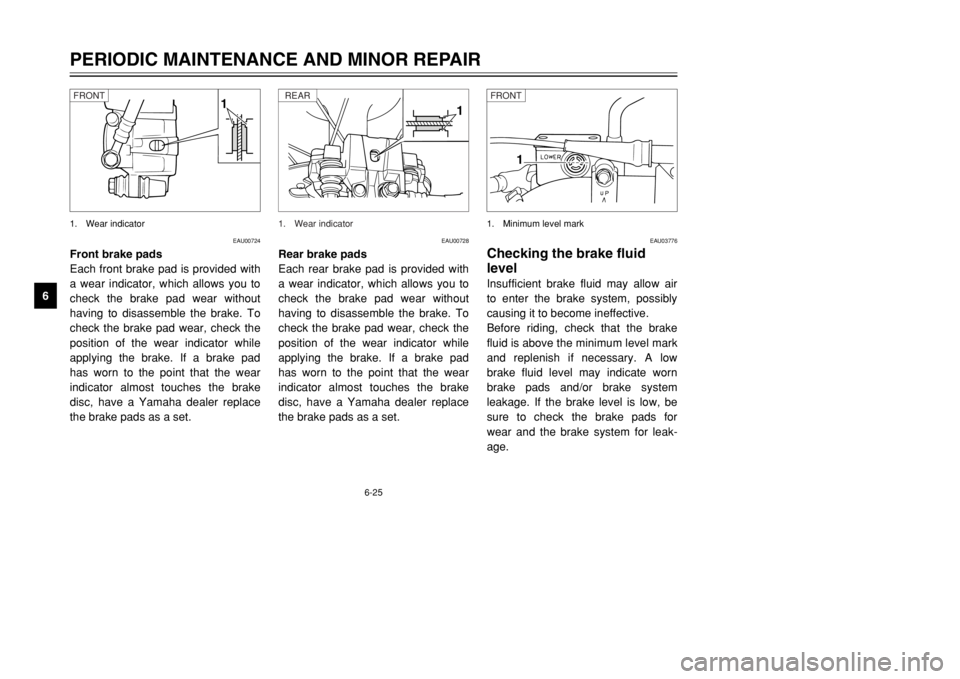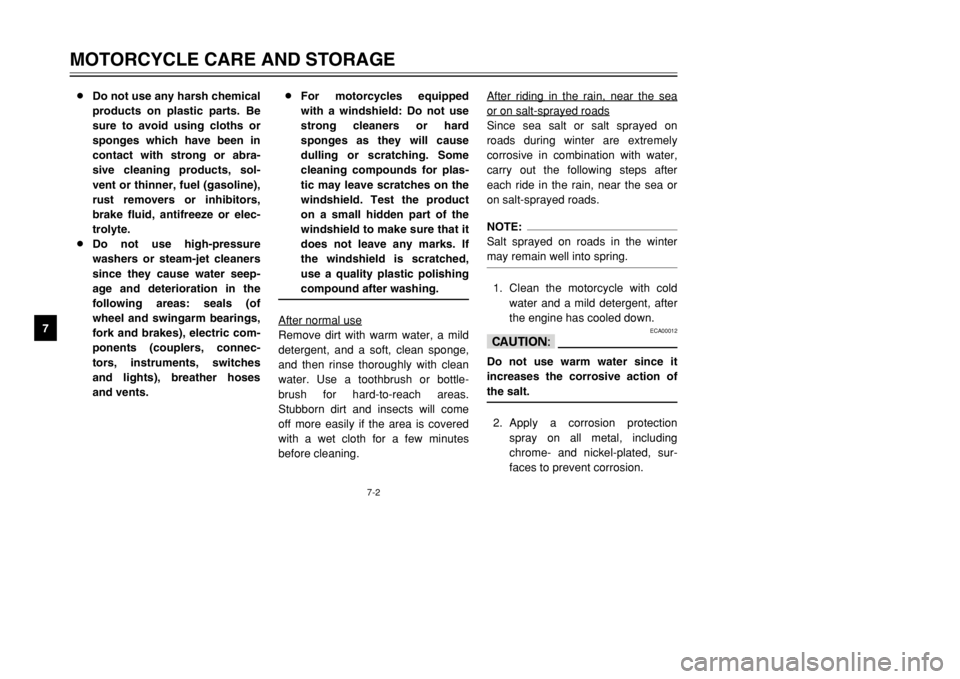brake fluid YAMAHA DT125R 2002 Owners Manual
[x] Cancel search | Manufacturer: YAMAHA, Model Year: 2002, Model line: DT125R, Model: YAMAHA DT125R 2002Pages: 96, PDF Size: 2.14 MB
Page 7 of 96

PERIODIC MAINTENANCE AND
MINOR REPAIR ................................................ 6-1
Owner’s tool kit ............................................... 6-1
Periodic maintenance and lubrication chart ... 6-2
Removing and installing cowlings .................. 6-5
Removing and installing panels ...................... 6-7
Checking the spark plug ................................. 6-9
Transmission oil ........................................... 6-10
Coolant ......................................................... 6-12
Changing the coolant ................................... 6-14
Cleaning the air filter element........................ 6-16
Adjusting the carburetor ............................... 6-17
Adjusting the engine idling speed ................ 6-17
Adjusting the throttle cable free play ............ 6-18
Tires ............................................................. 6-19
Spoke wheels ............................................... 6-21
Adjusting the clutch lever free play ............... 6-22
Adjusting the brake lever free play ............... 6-23
Adjusting the brake pedal position ............... 6-23
Adjusting the rear brake light switch ............. 6-24
Checking the front and rear brake pads ....... 6-24
Checking the brake fluid level ...................... 6-25
Changing the brake fluid .............................. 6-26
Drive chain slack .......................................... 6-27
Lubricating the drive chain ........................... 6-28
Checking and lubricating the cables ............. 6-29Checking and lubricating the
throttle grip and cable ................................ 6-29
Adjusting the Autolube pump ....................... 6-30
Checking and lubricating the brake and
shift pedals ................................................ 6-30
Checking and lubricating the brake and
clutch levers .............................................. 6-30
Checking and lubricating the sidestand ....... 6-31
Checking the front fork ................................. 6-31
Checking the steering ................................... 6-32
Checking the wheel bearings ....................... 6-32
Battery .......................................................... 6-33
Replacing the fuse ....................................... 6-35
Replacing the headlight bulb ........................ 6-36
Replacing a turn signal light bulb ................. 6-37
Replacing the tail/brake light bulb ................ 6-38
Supporting the motorcycle ............................ 6-39
Front wheel ................................................... 6-39
Rear wheel ................................................... 6-42
Troubleshooting ............................................ 6-43
Troubleshooting charts ................................. 6-44
MOTORCYCLE CARE AND STORAGE ........... 7-1
Care ................................................................ 7-1
Storage ........................................................... 7-4
TABLE OF CONTENTS6
7
3MB-9-E8 6/13/01 10:55 AM Page 6
Page 31 of 96

4-1
EAU01114
PRE-OPERATION CHECKS
4The condition of a vehicle is the owner’s responsibility. Vital components can start to deteriorate quickly and unexpect-
edly, even if the vehicle remains unused (for example, as a result of exposure to the elements). Any damage, fluid leak-
age or loss of tire air pressure could have serious consequences. Therefore, it is very important, in addition to a thor-
ough visual inspection, to check the following points before each ride.
EAU03439
Pre-operation check list
ITEM CHECKS PAGE
Fuel•Check fuel level in fuel tank.
•Refuel if necessary.
•Check fuel line for leakage.3-5–3-7
2-stroke engine oil•Check oil level in oil tank.
•If necessary, add recommended oil to specified level.
•Check vehicle for oil leakage.3-8
Transmission oil•Check oil level in transmission case.
•If necessary, add recommended oil to specified level.6-10–6-12
Coolant•Check coolant level in reservoir.
•If necessary, add recommended coolant to specified level.
•Check cooling system for leakage.6-12–6-15
Front brake•Check operation.
•If soft or spongy, have Yamaha dealer bleed hydraulic system.
•Check lever free play.
•Adjust if necessary.
•Check fluid level in reservoir.
•If necessary, add recommended brake fluid to specified level.
•Check hydraulic system for leakage.3-5, 6-23, 6-24–6-26
Rear brake•Check operation.
•If soft or spongy, have Yamaha dealer bleed hydraulic system.
•Check fluid level in reservoir.
•If necessary, add recommended brake fluid to specified level.
•Check hydraulic system for leakage.3-5, 6-23–6-26
3MB-9-E8 6/13/01 10:55 AM Page 30
Page 40 of 96

6-2
PERIODIC MAINTENANCE AND MINOR REPAIR
6
NO. ITEM CHECK OR MAINTENANCE JOBODOMETER READING (× 1,000 km)
ANNUAL
CHECK
1 6 12 18 24
1
*Fuel line•Check fuel hoses for cracks or damage.√√√√ √
2 Spark plug•Replace.√√√√ √
3 Air filter element•Clean.√√
•Replace.√√
4*Battery•Check electrolyte level and specific gravity.
•Make sure that the breather hose is properly routed.√√√√ √
5 Clutch•Check operation.
•Adjust.√√√√√
6*Front brake•Check operation, fluid level and vehicle for fluid leakage.
(See NOTE on page 6-4.)√√√√√ √
•Replace brake pads.Whenever worn to the limit
7*Rear brake•Check operation, fluid level and vehicle for fluid leakage.
(See NOTE on page 6-4.)√√√√√ √
•Replace brake pads.Whenever worn to the limit
8*Brake hoses•Check for cracks or damage.√√√√ √
•Replace. (See NOTE on page 6-4.)Every 4 years
EAU03686
Periodic maintenance and lubrication chart
NOTE:
8The annual checks must be performed every year, except if a kilometer-based maintenance is performed instead.
8From 30,000 km, repeat the maintenance intervals starting from 6,000 km.
8Items marked with an asterisk should be performed by a Yamaha dealer as they require special tools, data and
technical skills.
3MB-9-E8 6/13/01 10:55 AM Page 39
Page 42 of 96

6-4
PERIODIC MAINTENANCE AND MINOR REPAIR
6
EAU03884
NOTE:
8The air filter needs more frequent service if you are riding in unusually wet or dusty areas.
8Hydraulic brake service
9Regularly check and, if necessary, correct the brake fluid level.
9Every two years replace the internal components of the brake master cylinders and calipers, and change the
brake fluid.
9Replace the brake hoses every four years and if cracked or damaged.21
*Carburetor•Check starter (choke) operation.
•Adjust engine idling speed.√√√√√ √
22*Autolube pump•Check operation.
•Bleed if necessary.√√√√
23 Transmission oil•Check oil level.√√√√√ √
•Change.√√
24*Cooling system•Check coolant level and vehicle for coolant leakage.√√√√ √
•Change.Every 3 years
25*Front and rear brake
switches•Check operation.√√√√√ √
26 Moving parts and cables•Lubricate.√√√√ √
27*Lights, signals and
switches•Check operation.
•Adjust headlight beam.√√√√√ √ NO. ITEM CHECK OR MAINTENANCE JOBODOMETER READING (× 1,000 km)
ANNUAL
CHECK
1 6 12 18 24
3MB-9-E8 6/13/01 10:55 AM Page 41
Page 63 of 96

6-25
PERIODIC MAINTENANCE AND MINOR REPAIR
6
EAU00724
Front brake pads
Each front brake pad is provided with
a wear indicator, which allows you to
check the brake pad wear without
having to disassemble the brake. To
check the brake pad wear, check the
position of the wear indicator while
applying the brake. If a brake pad
has worn to the point that the wear
indicator almost touches the brake
disc, have a Yamaha dealer replace
the brake pads as a set.
1
1. Wear indicator
EAU03776
Checking the brake fluid
levelInsufficient brake fluid may allow air
to enter the brake system, possibly
causing it to become ineffective.
Before riding, check that the brake
fluid is above the minimum level mark
and replenish if necessary. A low
brake fluid level may indicate worn
brake pads and/or brake system
leakage. If the brake level is low, be
sure to check the brake pads for
wear and the brake system for leak-
age.
1
1. Minimum level mark
EAU00728
Rear brake pads
Each rear brake pad is provided with
a wear indicator, which allows you to
check the brake pad wear without
having to disassemble the brake. To
check the brake pad wear, check the
position of the wear indicator while
applying the brake. If a brake pad
has worn to the point that the wear
indicator almost touches the brake
disc, have a Yamaha dealer replace
the brake pads as a set.
1
1. Wear indicator
FRONT
REAR
FRONT
3MB-9-E8 6/13/01 10:55 AM Page 62
Page 64 of 96

6-26
PERIODIC MAINTENANCE AND MINOR REPAIR
6 Observe these precautions:
8When checking the fluid level,
make sure that the top of the
brake fluid reservoir is level.
8Use only the recommended qual-
ity brake fluid, otherwise the rub-
ber seals may deteriorate, caus-
ing leakage and poor braking
performance.
1
1. Minimum level mark
EAU03976
Changing the brake fluidHave a Yamaha dealer change the
brake fluid at the intervals specified in
the NOTE after the periodic mainte-
nance and lubrication chart. In addi-
tion, have the oil seals of the master
cylinders and calipers as well as the
brake hoses replaced at the intervals
listed below or whenever they are
damaged or leaking.
8Oil seals: Replace every two
years.
8Brake hoses: Replace every four
years. 8Refill with the same type of brake
fluid. Mixing fluids may result in a
harmful chemical reaction and
lead to poor braking perfor-
mance.
8Be careful that water does not
enter the brake fluid reservoir
when refilling. Water will signifi-
cantly lower the boiling point of
the fluid and may result in vapor
lock.
8Brake fluid may deteriorate paint-
ed surfaces or plastic parts.
Always clean up spilled fluid
immediately.
8As the brake pads wear, it is nor-
mal for the brake fluid level to
gradually go down. However, if
the brake fluid level goes down
suddenly, have a Yamaha dealer
check the cause.
REARRecommended brake fluid:
DOT 4
3MB-9-E8 6/13/01 10:55 AM Page 63
Page 85 of 96

7-2
MOTORCYCLE CARE AND STORAGE
78Do not use any harsh chemical
products on plastic parts. Be
sure to avoid using cloths or
sponges which have been in
contact with strong or abra-
sive cleaning products, sol-
vent or thinner, fuel (gasoline),
rust removers or inhibitors,
brake fluid, antifreeze or elec-
trolyte.
8Do not use high-pressure
washers or steam-jet cleaners
since they cause water seep-
age and deterioration in the
following areas: seals (of
wheel and swingarm bearings,
fork and brakes), electric com-
ponents (couplers, connec-
tors, instruments, switches
and lights), breather hoses
and vents.8For motorcycles equipped
with a windshield: Do not use
strong cleaners or hard
sponges as they will cause
dulling or scratching. Some
cleaning compounds for plas-
tic may leave scratches on the
windshield. Test the product
on a small hidden part of the
windshield to make sure that it
does not leave any marks. If
the windshield is scratched,
use a quality plastic polishing
compound after washing.
After normal useRemove dirt with warm water, a mild
detergent, and a soft, clean sponge,
and then rinse thoroughly with clean
water. Use a toothbrush or bottle-
brush for hard-to-reach areas.
Stubborn dirt and insects will come
off more easily if the area is covered
with a wet cloth for a few minutes
before cleaning.After riding in the rain, near the sea
or on salt-sprayed roadsSince sea salt or salt sprayed on
roads during winter are extremely
corrosive in combination with water,
carry out the following steps after
each ride in the rain, near the sea or
on salt-sprayed roads.NOTE:
Salt sprayed on roads in the winter
may remain well into spring.1. Clean the motorcycle with cold
water and a mild detergent, after
the engine has cooled down.
ECA00012
cCDo not use warm water since it
increases the corrosive action of
the salt.2. Apply a corrosion protection
spray on all metal, including
chrome- and nickel-plated, sur-
faces to prevent corrosion.
3MB-9-E8 6/13/01 10:55 AM Page 84
Page 91 of 96

8-3
SPECIFICATIONS
8
90 kg load–maximum
load*
Front150 kPa (1.50 kgf/cm
2, 1.50 bar)
Rear 175 kPa (1.75 kgf/cm2, 1.75 bar)
Off-road riding
Front125 kPa (1.25 kgf/cm2, 1.25 bar)
Rear 150 kPa (1.50 kgf/cm2, 1.50 bar)
*Total weight of rider, passenger, cargo and accessories
Wheels
Front
Type Spoke wheel
Size 1.60 ×21
Rear
Type Spoke wheel
Size 1.85 ×18
Brakes
Front
Type Single disc brake
Operation Right hand operation
Fluid DOT 4Rear
Type Single disc brake
Operation Right foot operation
Fluid DOT 4
Suspension
Front Telescopic fork
Rear Swingarm (link suspension)
Shock absorber
Front Coil spring/oil damper
Rear Coil-gas spring/oil damper
Wheel travel
Front 270 mm
Rear 260 mm
Electrical
Ignition system C.D.I.
Charging system
Type A.C. magneto
Standard output 14V, 100W @ 5,000 r/min
3MB-9-E8 6/13/01 10:55 AM Page 90